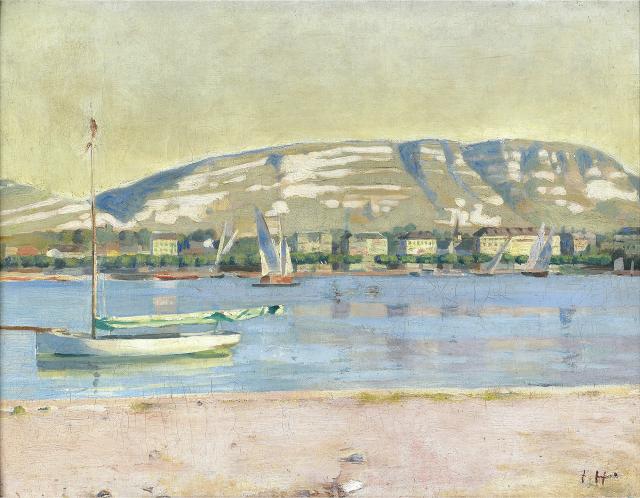Following his studies under Barthélemy Menn, Ferdinand Hodler looks to develop a more intense, natural light in his painting, as can be seen in La Rade de Genève et le Salève (The Genevan Lakefront and the Salève).
Painted in 1878 from the embankment along the lake’s right shore in Geneva (and later reworked after his return from a stay in Spain), this work also manifests the artist’s growing interest in geology, visible in his treatment of the different strata layering the city’s two well-known nearby mountains, the Petit and Grand Salève. In 1879 Hodler will take the geology course given by Professor Carl Vogt, which will make a lifelong impression on him, “He taught me to see nature in the laws governing it and showed me that everything occurring in nature is always the repeated application of unchanging laws”.
In 1885, driven by the wish to encompass the universal order, Hodler elaborates the principle of “Parallelism”, which he understands as a repetition of similar elements: “I call all kinds of repetitions of forms associated with repetitions of colours Parallelism”. For him it is actually a natural law that he is endeavouring to apply in his painting like a visionary who is getting closer to absolute values. Already the way he has chosen to frame his landscape here to emphasise the piling up of the horizontal lines of the embankment, the lake, its reflections, and finally the Salève points forward to the theory of Parallelism, which he alone will lay claim to.
Painted in 1878 from the embankment along the lake’s right shore in Geneva (and later reworked after his return from a stay in Spain), this work also manifests the artist’s growing interest in geology, visible in his treatment of the different strata layering the city’s two well-known nearby mountains, the Petit and Grand Salève. In 1879 Hodler will take the geology course given by Professor Carl Vogt, which will make a lifelong impression on him, “He taught me to see nature in the laws governing it and showed me that everything occurring in nature is always the repeated application of unchanging laws”.
In 1885, driven by the wish to encompass the universal order, Hodler elaborates the principle of “Parallelism”, which he understands as a repetition of similar elements: “I call all kinds of repetitions of forms associated with repetitions of colours Parallelism”. For him it is actually a natural law that he is endeavouring to apply in his painting like a visionary who is getting closer to absolute values. Already the way he has chosen to frame his landscape here to emphasise the piling up of the horizontal lines of the embankment, the lake, its reflections, and finally the Salève points forward to the theory of Parallelism, which he alone will lay claim to.
